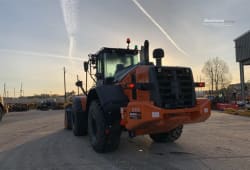Powerful Cold Planers for Precise Road Milling
9 Min read
)
January 27, 2024
When it comes to road construction and maintenance, one of the crucial steps is the preparation of the road surface. This process, known as milling or planing, involves removing the top layer of the existing road to create a smooth and even surface for repaving or resurfacing. To accomplish this task efficiently, road construction professionals rely on a specialized piece of equipment called Cold Planers. In this comprehensive guide, we will explore what cold planers are, how they work, their various types, and why they are essential in modern road construction and maintenance.
Understanding Cold Planers
What Are Cold Planers?
Cold planers, also known as asphalt milling machines or pavement planers, are heavy-duty machines designed for the removal of asphalt or concrete surfaces. They play a critical role in road rehabilitation, repair, and maintenance projects. These machines are equipped with a rotating drum fitted with teeth or cutting bits that grind and remove the surface material effectively.
How Do Cold Planers Work?
The working principle of cold planers is straightforward yet highly effective. Here's a step-by-step breakdown of how they operate:
Surface Preparation: Before starting the milling process, the work area needs to be adequately prepared. This includes marking the area to be milled, ensuring safety measures are in place, and securing any nearby structures. Proper preparation is essential for a successful milling operation.
Milling Drum Operation: The heart of the cold planer is its milling drum, which houses a series of cutting bits. This drum rotates and moves horizontally along the surface to be milled. As the drum turns, the cutting bits dig into the pavement, gradually removing the top layer.
Material Collection: During road construction or repairs, existing pavement is typically removed to make way for new surfaces. The removed material, which can be asphalt, concrete, or other pavement materials, is collected by a conveyor system and loaded into a waiting truck for disposal or recycling. This process ensures sustainable and efficient road maintenance.
Adjustable Depth Control: In construction and roadwork projects, heavy machinery like excavators and bulldozers play a crucial role. Operators can adjust the milling depth according to the project specifications, ensuring precise removal of the desired amount of material. These machines are equipped with advanced technology for efficient and accurate performance.
Quality Control: During the milling process, skilled operators meticulously control the machinery to precisely shape raw materials into desired forms. Throughout this process, operators monitor the quality of the milled surface to ensure it meets the required specifications, guaranteeing top-notch final products.
Types of Cold Planers
:format(webp))
Cold planers come in various types, each designed for specific applications and project sizes. Here are the primary types:
Small Cold Planers
Small cold planers are compact machines designed for minor road repairs and maintenance. They are ideal for removing surface irregularities, such as bumps, potholes, and cracks, to create a smoother driving surface. These machines are highly maneuverable and suitable for working in tight spaces.
Medium Cold Planers
Medium-sized cold planers are versatile machines suitable for a wide range of applications. They are commonly used for milling larger road sections, parking lots, and industrial areas. With adjustable cutting widths and depths, they offer flexibility for various project requirements.
Large Cold Planers
Large cold planers, also known as high-production cold planers, are heavy-duty machines designed for major road reconstruction and resurfacing projects. They are capable of milling wide and deep sections of roads quickly, making them essential for highway and interstate construction.
Advantages of Using Cold Planers
The use of cold planers in road construction and maintenance offers several advantages:
Cost-Effective
Cold planers help in the efficient removal of damaged or deteriorated road surfaces, reducing the need for costly full-depth repairs or reconstruction.
Precise Milling
These machines offer precise control over the milling depth, ensuring that only the necessary amount of material is removed, preserving the structural integrity of the road.
Reduced Downtime
Road closures and traffic disruptions are minimized since cold planers can quickly and effectively remove damaged pavement, allowing for faster repairs and resurfacing.
Recycling Potential
The material removed by cold planers can often be recycled and used in new road construction, reducing the demand for new resources and lowering environmental impact.
Improved Safety
Smoothing out road surfaces using cold planers enhances driving safety by eliminating hazards like potholes and uneven surfaces.
Key Features to Consider When Choosing a Cold Planer
Before investing in a cold planer for your road construction or maintenance project, it's essential to consider several key features:
Milling Width and Depth
When selecting a milling machine for your project, it's crucial to choose one with milling specifications that align with your specific requirements. Different cold planers provide varying cutting widths and depths, allowing you to tailor your equipment choice to the job's needs effectively.
Power Source
Cold planers are versatile machines used in road construction to remove asphalt or concrete surfaces. They efficiently grind and remove old pavement, preparing it for resurfacing. Cold planers can be powered by diesel engines or electric motors. The choice depends on factors like project location and environmental considerations.
Operator Comfort and Safety
When selecting heavy machinery for your construction project, prioritize operator comfort and safety. Ensure the machine includes features like ergonomic controls and visibility enhancements to maximize efficiency and minimize risks on the job site.
Maintenance Requirements
When choosing a cold planer for your roadwork needs, also factor in maintenance and spare parts availability. Regular upkeep is crucial for machine longevity, so prioritize models that offer ease of maintenance and readily available spare parts.
The Future of Cold Planers
As technology continues to advance, the field of road construction and maintenance is not left behind. Cold planers, like many other construction machines, have seen significant improvements over the years. These innovations are aimed at making the milling process more efficient, cost-effective, and environmentally friendly.
Innovative Advancements in Cold Planer Technology
Telematics and GPS Integration
Modern cold planers often come equipped with telematics systems and GPS integration. These technologies allow operators and project managers to track the machine's performance, monitor fuel consumption, and optimize routing and milling paths. Real-time data can be invaluable for improving efficiency and reducing downtime.
Automated Controls
Some cold planers now feature automated controls and guidance systems. These systems can help operators maintain a consistent milling depth and width, resulting in a more uniform surface finish. Automated controls also reduce the risk of human error, enhancing overall project quality.
Eco-Friendly Options
Environmental considerations are increasingly important in construction. Many cold planer manufacturers now offer eco-friendly options. This includes machines with lower emissions, improved fuel efficiency, and the ability to use alternative fuels.
Enhanced Safety Features
Safety remains a top priority in the construction industry. Newer cold planers are equipped with advanced safety features such as collision avoidance systems, cameras, and proximity sensors, reducing the risk of accidents on the job site.
Cold Planer Maintenance and Best Practices
To maximize the benefits of your cold planer and ensure its longevity, proper maintenance is crucial. Here are some maintenance tips and best practices:
Regular Inspections
Perform daily pre-operation inspections to check for any visible damage, loose bolts, or worn-out parts. Address any issues promptly to avoid costly downtime.
Lubrication and Fluid Checks
Ensure that all lubrication points are adequately greased, and hydraulic fluids, engine oil, and coolant levels are within recommended ranges.
Teeth and Cutting Bits Replacement
Monitor the condition of cutting bits and teeth on the milling drum. Replace them when they show signs of wear to maintain efficient milling performance.
Dust Control
Dust control is essential for the health and safety of workers and nearby residents. Use effective dust control systems and follow local regulations to minimize dust emissions.
Operator Training
Properly train operators on the use of the cold planer, including safety procedures and machine controls. Well-trained operators are more likely to operate the equipment efficiently and safely.
The Role of Cold Planers in Sustainable Construction
Sustainability is a growing concern in the construction industry. Cold planers play a vital role in sustainable construction practices in several ways:
Material Recycling
As mentioned earlier, the material removed by cold planers can often be recycled and reused in new road construction. This reduces the need for virgin materials and lowers the environmental impact of road projects.
Emission Reduction
The adoption of eco-friendly cold planers with reduced emissions and improved fuel efficiency contributes to lower overall greenhouse gas emissions from construction activities.
Efficiency and Reduced Waste
Efficient milling by cold planers ensures that only the damaged or deteriorated pavement is removed, minimizing waste and reducing the need for disposal.
Conclusion
Cold planers have come a long way from their humble beginnings, and they continue to play a vital role in modern road construction and maintenance. As technology advances and environmental concerns become more prominent, the industry can expect further innovations in cold planer design and functionality.
When considering a cold planner for your next project, remember to evaluate the latest technological advancements, maintenance requirements, and sustainability features to make the most informed decision. With the right cold planer and proper maintenance practices, you can contribute to safer, more efficient, and more sustainable road construction and maintenance projects.

Rex Walz is Boom & Bucket's Manager of Supplier Relations, bringing over a decade of experience in B2B sales and heavy equipment solutions. With a background spanning government, construction, industrial, and commercial sectors, he has a proven track record of driving growth and building trusted customer relationships. At Boom & Bucket, Rex is passionate about helping partners succeed while advancing the company's mission to create the most trusted marketplace for heavy equipment.














